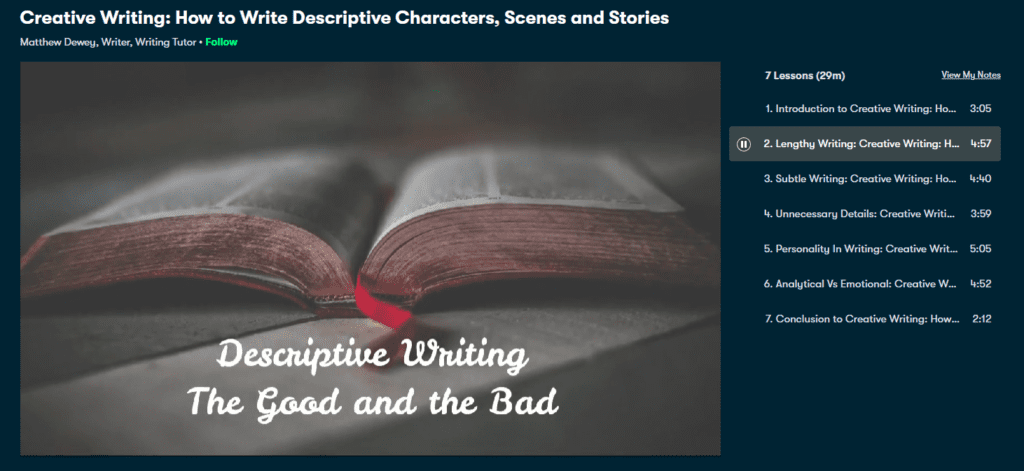You’ve probably heard that there are only six kinds of stories in the world. In the same way, you can boil down almost all writing to these four writing styles: expository, descriptive, persuasive and narrative.
Each writing style has its strengths, and the style you use means changing your vocabulary, grammar and tone to fit. Learning to use them all is an essential exercise in becoming a more flexible and expressive writer.
But just knowing their names isn’t enough! You’ve got to learn how they work, and how to use them.
Let’s explore each of the writing styles, what they look like and how they can strengthen your own writing style.
Spread the word with exposition
The point of exposition is to tell someone something that they didn’t know before. You’re presenting information in a clear and direct manner, whether that’s real-world facts or details about a fictional universe.
Your goal here isn’t to convince the reader of anything, but just lay out the truth as neatly as possible. This makes it the style of writing most common for newspapers and encyclopedias, but almost anything published contains some exposition.
An example of expository writing styles would look like this:
The left and right sides of a ship are often called ‘port’ and ‘starboard’, respectively. As the National Ocean Service explains, this helps sailors keep track of direction at sea.
Expository writing often uses outside pieces of evidence, like that link, to support what it’s saying. It can explain why things are the way they are, but it doesn’t say how they should be. It would be strange if a cookbook told you what meals to eat, and not just how to cook them!
Here’s a final tip for expository writing: make sure what you’re writing has value! Sit back, read what you just wrote, and ask yourself, “so what?”. This is one of many writing strategies you can use to improve your writing.
How to use descriptive writing styles
When we’re describing something, we want to share what it’s like on a level deeper than plain facts. It’s not enough to say that you ate ice cream – you want the reader to understand just how delicious and refreshing it was, too.
There are a lot of ways to accomplish that. That sentence used one of the simplest: adjectives like ‘delicious’ or ‘refreshing’, which add extra information to nouns and paint a more vivid image than the noun would on its own.
But we can also take this up a notch and start speaking with metaphors:
The boxer was an enraged bull trying to trample his opponent underfoot.
Boxers aren’t particularly similar to bulls—most boxers don’t have horns, for a start!
But metaphors like this let readers think of what bulls are like (big, strong, aggressive) and apply that to the boxer. Using figurative language like this is a powerful tool for painting vivid images quickly.
The below Skillshare course by published author Matthew Dewey has great practical techniques for the descriptive writing style.

Particularly useful is the lesson on cutting unnecessary detail because a common beginner mistake when using this writing style is going overboard. Adding too much information detracts from your main point—don’t use ten mediocre words when one perfect one will do.

Creative Writing: How to Write Descriptive Characters, Scenes and Stories
Learn the differences between lengthy and short writing, and how to keep your reader engaged by creating descriptions that match your style and genre.
Creative Writing: How to Write Descriptive Characters, Scenes and Stories
Learn the differences between lengthy and short writing, and how to keep your reader engaged by creating descriptions that match your style and genre.
The style of writing persuasively
Persuasion is something we do every day, even if we don’t realize it. It’s the art of getting people to do what we want by making them think it’s a good idea. As writers are too gentle and kind-hearted to threaten or coerce people, persuasion is our bread and butter.
Of all the writing styles, this one is used the most in advertising, but it appears in countless other places. A magazine telling you to save the planet is writing persuasively, and so is an academic article explaining why what they’re saying is correct.
Being persuasive often means appealing to what people already think and giving evidence for why they should agree with you. Take this as an example:
If you care about your health, you know how important a balanced diet is. But are you getting enough calcium? Buy our new cereal today to help fight off osteoporosis.
This example flatters the reader by assuming they already know about the importance of a healthy diet. It then offers a problem—a lack of calcium—before offering a solution, which is their new cereal.
The direct command to ‘buy it today’ is known as a ‘call to action’, and it’s an essential part of persuasion. Why not practice making some to improve your own writing style?
Want to improve your persuasive writing? Check out the course from Forbes contributors Renee Sylvestre-Williams & Matthew Rolnick, or view our full catalog of online writing courses.
Telling stories through narratives
When most people think of narrative writing styles, their minds naturally go to novels and books. While those are great examples of the narrative writing style, they’re not the only ones.
Biographies and documentaries are narratives, and even our casual conversations regularly contain them. Here’s an example:
Sorry I was late today. I forgot to set my alarm last night, so this morning I woke up late and got stuck in rush-hour traffic. I’ll make it up to you and come in early tomorrow, OK?
What makes this the narrative writing style? It’s because we’re linking together separate events into one story. When you read that, you understood that not setting the alarm and waking up late were linked. One of them made the other happen.
In other words, all narratives are really just examples of cause and effect.
Another common feature is dealing with time. That example covers the past, present and future, and while it’s not necessary, most narratives start in the past and work their way forward. This sense of progression is very natural and easy for people to understand.
Studying narratives is most fun when you’re using them for creative writing. The below Domestika course on narrative writing by acclaimed author Albert Chimal will guide you through the process so that you are able to create memorable narratives.

Introduction to Narrative Writing
Learn everything you need to know to start writing memorable stories, step by step in this narrative writing course.
Introduction to Narrative Writing
Learn everything you need to know to start writing memorable stories, step by step in this narrative writing course.
Even if you don’t want to be a novelist, creative writing is a critical skill. Challenge yourself!
Finding your own writing style
The most skilled writers know that while we have names for these different writing styles, in reality, almost every interesting piece of work we create mixes different styles together. This is one of the top things you’ll discover when learning how to become a writer.
A biography is an exposition of someone’s life, sure, but it’s also a narrative. One of the most effective ways to be persuasive is to describe why what you want is a good idea. And you only need to pick up a novel to see the link between narrative and description.
Finding your own writing style isn’t a question of simply picking the style of writing that sounds best. It means treating them like bricks that you use together to build a house.
If this has sparked your imagination and you want to learn more, why not take this a writing masterclass to further boost your skills, or check out our extensive catalog of online writing courses? You’ll quickly learn real-world skills that expand your vocabulary, strengthen your sentences and deepen your writing habit.
Learning these writing styles was the first step. Take an online course to start the marathon.
